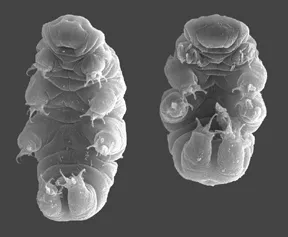How Does the Tiny Waterbear Survive in Outer Space?
A special adaptation allows the tiny animal known as the tardigrade to curl up into a dry, lifeless ball and survive for decades
/https://tf-cmsv2-smithsonianmag-media.s3.amazonaws.com/filer/20120911105038tardigrade-small.jpg)
The humble tardigrade, also known as a “waterbear” or “moss piglet,” is an aquatic eight-legged animal that typically grows no longer than one millimeter in length. Most tardigrades (there are more than 1,000 identified species) have a fairly humdrum existence, living out their days on a moist piece of moss or in the sediment at the bottom of a lake and feeding on bacteria or plant life.
Some tardigrades, though, live on the wild side. Scientists have found the tiny creatures surviving in boiling hot springs and buried under layers of ice on Himalayan mountaintops. Experiments have shown that they can survive being frozen at -328 degrees Fahrenheit or heated to more than 300 degrees F, are capable of withstanding pressures as powerful as 6000 times that of the atmosphere and can survive radiation doses that are thousands of times stronger than what would be fatal for a human.
In 2007, a group of European researchers pushed the resilience of this extraordinary animal even further, exposing a sample of dehydrated tardigrades to the vacuum and solar radiation of outer space for 10 full days. When the specimens were returned to earth and rehydrated, 68 percent of those that were shielded from the radiation survived, and even a handful of those with no radiation protection came back to life and produced viable offspring.
How do the little tardigrades survive such a harsh environment? Although amateur tardigrade enthusiast Mike Shaw recently made waves by postulating that the animals may be equipped to survive in outer space because they originally came from other planets, scientists are certain that the creatures developed their uncommon toughness here on earth.

It turns out that the adaptation that allows tardigrades to live through these trying conditions is their ability to enter a dehydrated state that closely resembles death. When encountering environmental stresses, a tardigrade curls up into a dry, lifeless ball called a tun, reducing its metabolic activity to as low as .01 percent of normal levels. In order to do so, tardigrades produce trehalose, a special protective sugar that forms a gel-like medium that suspends and preserves the organelles and membranes that make up the animal’s cells.
As a tun, a tardigrade can survive for decades or even longer; once immersed in water, the body returns to a normal metabolic state over the course of a few hours. One group of dehydrated tardigrades was reportedly taken from a museum sample of dried moss that was more than 100 years old and brought back to life. The longer a tardigrade persists in a dehydrated state, though, the lower the chances it will successfully be revived afterward.
The creatures are also capable of other types of transformations that allow them to survive in difficult conditions. If the oxygen content of their water medium drops too low for them to extract enough of the gas for respiration, they stretch out into a long, relaxed state, in which their metabolic rate is also reduced but the relaxation of their muscles allows as much water and oxygen to enter their cells as possible. If the temperature of a tardigrade’s environment falls below freezing, it forms a special cold-resistant tun, with molecules that prevent the formation of large ice crystals that could damage cell membranes.
This remarkably wide range of survival techniques leads to an obvious question: If tardigrades aren’t from outer space, just what barren environment did they actually evolve in? Although the exact placement of tardigrades in the evolutionary tree of life is still debated, scientists believe they are most closely related to arthropods, a phylum of animals with hard protective exoskeletons and that includes insects and crustaceans.
Unlike most arthropods, however, the hardy species of tardigrades likely evolved to survive in especially volatile environments, such as lakes that intermittently freeze or dry up. As a result, they’re capable of surviving the rigors of outer space, more perilous than any environment on earth. And for all we know about the tardigrades, you’d have to assume—if they can make it there, they can make it anywhere.
/https://tf-cmsv2-smithsonianmag-media.s3.amazonaws.com/accounts/headshot/joseph-stromberg-240.jpg)
/https://tf-cmsv2-smithsonianmag-media.s3.amazonaws.com/accounts/headshot/joseph-stromberg-240.jpg)